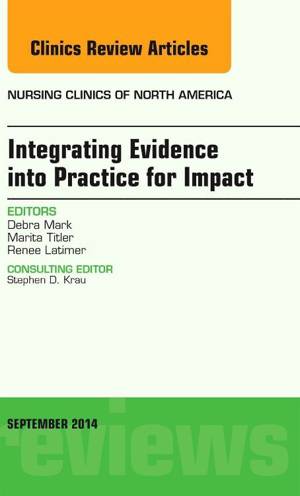
- Afhalen na 1 uur in een winkel met voorraad
- Gratis thuislevering in België vanaf € 30
- Ruim aanbod met 7 miljoen producten
- Afhalen na 1 uur in een winkel met voorraad
- Gratis thuislevering in België vanaf € 30
- Ruim aanbod met 7 miljoen producten
Zoeken
Integrating Evidence Into Practice for Impact, an Issue of Nursing Clinics of North America
Volume 49-3
Debra Mark
€ 159,45
+ 318 punten
Omschrijving
This issue begins with an overview that distinguishes evidence-based practice (EBP) and translation science, followed by a description of Hawaii's statewide EBP program that uses active and multifaceted translation science strategies to facilitate the rate and extent of adoption of EBP changes. With one exception, the remaining articles describe individual EBP projects from five different health care facilities that used the Iowa Model to guide their work. Each article includes an evidence summary, a description of implementation strategies, an evaluation of the innovation, and lessons learned. These completed projects were initiated between 2009 and 2012, address a variety of topical nursing issues, and, for the most part, focus on preventing complications (ie, blood sugar elevations, increased lengths of stay, extubation failures, noise-related injury, pain, surgical site infections, pneumonia, restraint use, delirium, and fever). An additional article describes the use of evidence to inform simulation-based learning, a possible strategy for ensuring competencies in and compliance with EBP interventions. Nursing leaders will come away with solid information about utilizing EBP to improve patient outcomes. The Hawaii program demonstrates that health care quality can be realized by employing the best available evidence and empowering the nursing workforce. It also offers a glimpse of the care that the future nursing workforce could provide to create a health system that provides accessible, affordable and quality care to everyone in the United States.
Specificaties
Betrokkenen
- Auteur(s):
- Uitgeverij:
Inhoud
- Taal:
- Engels
- Reeks:
- Reeksnummer:
- nr. 49
Eigenschappen
- Productcode (EAN):
- 9780323323338
- Verschijningsdatum:
- 4/09/2014
- Uitvoering:
- Hardcover
- Formaat:
- Genaaid
- Afmetingen:
- 152 mm x 229 mm
- Gewicht:
- 519 g

Alleen bij Standaard Boekhandel
+ 318 punten op je klantenkaart van Standaard Boekhandel
Beoordelingen
We publiceren alleen reviews die voldoen aan de voorwaarden voor reviews. Bekijk onze voorwaarden voor reviews.











